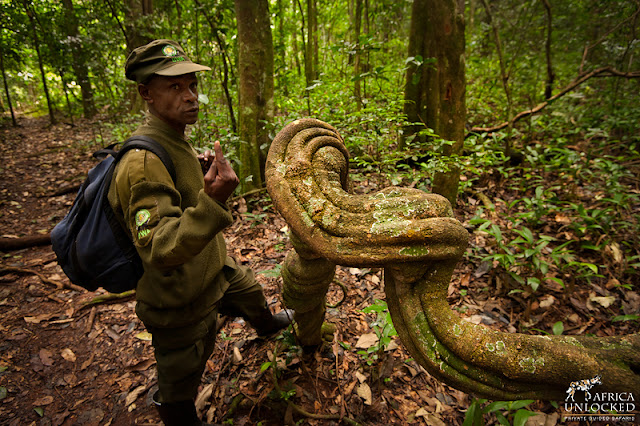 |
| Stunning savannah landscapes in Murchison Falls National Park. |
The flight into Entebbe was an unexpected surprise. For some
reason the pilot descended quite low over lake Victoria revealing the lake
islands with its fishing communities and seemingly lost fishing boats on the
vast expanse of the lake.
After
effortless custom procedures, courtesy of Premier Safaris, we proceeded to the
Boma Guest house only minutes from the airport where safari guests met up at
dinner.
Uganda is a fresh, wonderful, clean and friendly destination with some of Africa's most surpizing experiences. It is fast becoming my favorite safari country. A true Ugandan welcome the next morning during breakfast by
the likes of Great Blue Turaco, Black and White Casqued Hornbills, Black-headed
Gonolek, Splendid Glossy Starlings and even a trio of Ross's Turacos made us all feel very welcome to
this verdant country. Rejuvenated we took on the road to our first destination,
Murchison falls National Park in the west of the country. After negotiating the
back roads of Kampala we eventually
turned onto the superb roads leading past emerald landscapes to the northern
sector of the Albertine or Western Rift Valley. Just before the park the road
leads through Budongo Forest, this alone being worth the trek. Myriads of
butterflies darted across the dirt road leading through the untouched forest
while secretive forest birds (most unfortunately unidentified) darted across
our path. This forest alone is worth a few days exploring but our itinerary
only allowed brief stops.
 |
| From a small rocky island in the White Nile one gets a view into the mouth of murchison Falls, The entire White Nile river crashes through a cap only 7 metres wide!!! |
The short detour to the top of Murchison falls is really
worth the effort as the White Nile River, (yes the one of legend and myth)
passes through the seven meter gap and plummets angrily into the valley 45
meters below. Undeniably one of Africa’s most spectacular places. One has to cross to the northern bank by ferry. Getting to this point and seeing the
vast river only emphasize the extent of the falls. While not the highest in
Africa by any stretch, the mere fact that this huge volume has to squeeze
through a narrow gap of only seven meters baffles the mind.
 |
| Yet another special - Uganda Kob. Every single image from this park has the most amazing luminous green background!! |
Murchison Falls is certainly now my “flavor of the month”.
The first game drive revealed Hippo returning to their watry beds, Patas Monkey
(a new species for all of us), dozens of Oribi, Buffalo, Rothchilds Giraffe,
Uganda Kob and a host of others. But top of the list must be the birds.
Murchison is one of the best places to see the enigmatic Shoebill and our first
morning produced two individual sightings as well as Abysinian Ground hornbill
and a glut of other avian jewels too many to mention.
In the afternoon we found ourselves ploughing our way upstream
against the current past herds of Elephant amongst the pristine riverine
forests. Ubiquitous herds of Hippo are scattered throughout although seeing
some of the monster crocs proved more difficult than anticipated. An
interesting stop was at the red – throated bee-eater colony. Although common
with the park these resplendent birds are a Murchison-Falls special and it was
great getting close up views and pics of them.
The following morning had us heading downstream towards the
delta where the Nile enters Lake Albert. Up until this point this section of
the White Nile is known as the Victoria Nile. Once it leaves Lake Albert is is
known as the Albert Nile. Top of our hit-list was close up images of Uganda’s
prime avian resident – Shoebill stork.
 |
| One of Africa's most sought-after bird. An African Shoebill filling our frames. Even the non-birders gets excited about this one. |
And the combination of great local knowledge (and incredible eyesight) from
Eric our premier Safaris guide and the boating skills of James who navigated
the shallow side channels resulted in more than frame filling images of one of
the worlds most bizarre looking and most sought after birds. I would like to
think that the above image would go some way toward illustrating our total awe at this sighting.
 |
| Part of the Nile landscape - local fisherman on Lake Albert. |
The big cats eluded us thus far though so our last game
drive was aimed at finding the big cats. One can be forgiven for thinking
Uganda is not a predator destination, yet surprisingly some of the Parks,
including Murchison offers great predator viewing.
 |
| There are some great lion viewing within the park if time allows you to look for them. |
Mission accomplished as we
encountered two adult lionesses and six cubs on our last drive, again in the
most brilliant green scenery an out in the open – posing beautifully for
photographs.
 |
| Abysinian Ground Hornbill - another local birding highlight. |
Murchison falls national park is wild, big and offers some
of the most diverse habitats and activities within a short distance. Dedicated
birders, specialist wildlife enthusiast, wildlife photographer or even
fisherman. Its all there. Now off to Kibale.



























